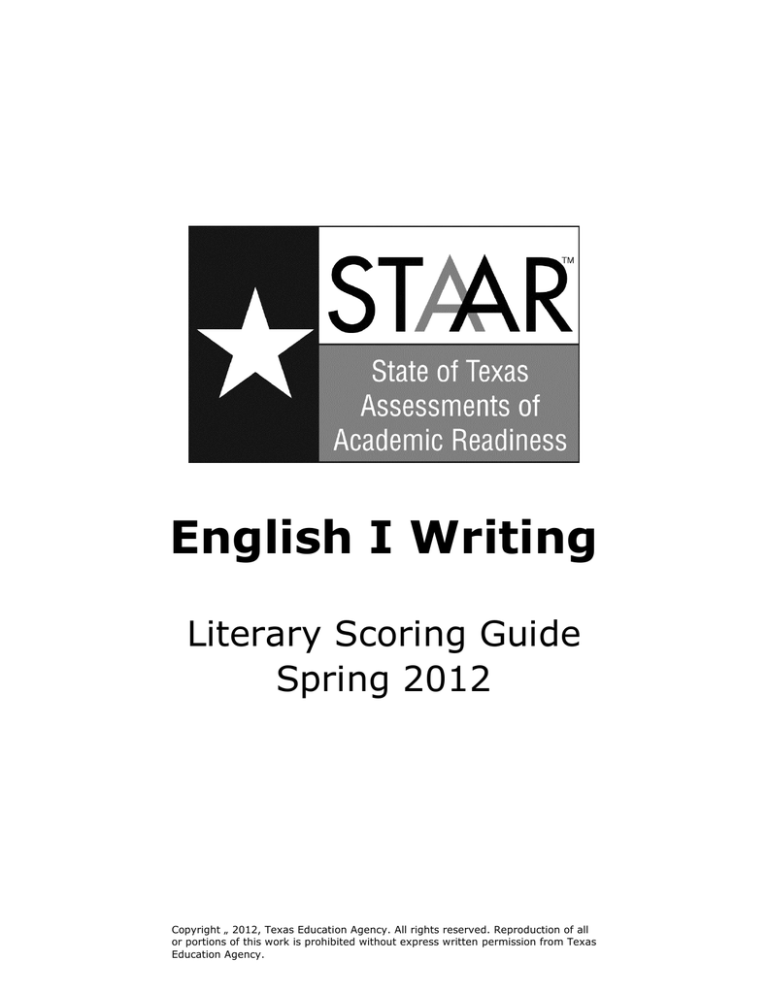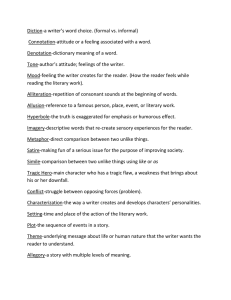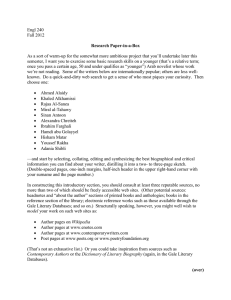
English I Writing
Literary Scoring Guide
Spring 2012
Copyright „ 2012, Texas Education Agency. All rights reserved. Reproduction of all
or portions of this work is prohibited without express written permission from Texas
Education Agency.
STAAR English I Literary Writing
Score Point 1
The story represents a very limited writing performance.
Organization/Progression
!
The form or structure of the story is inappropriate to the purpose or the
specific demands of the prompt. The writer uses narrative strategies or
literary devices that are only marginally suited to the literary task, or they
are inappropriate or not evident at all. The writer presents the story in a
random or illogical way, causing it to lack clarity and direction.
!
Many of the details do not contribute to the story. The writer’s lack of focus
on a specific character, event, or idea weakens the unity and coherence of
the story.
!
The writer’s presentation of the story is weak. Repetition or wordiness
sometimes causes serious disruptions in the story line. At other times the
lack of meaningful transitions and sentence-to-sentence connections makes
one or more parts of the story unclear or difficult to follow.
Development of Ideas
!
The development of the story is weak because the details are inappropriate,
vague, or insufficient. They do not contribute to key literary elements such as
character development, conflict, and point of view.
!
The story is insubstantial because the writer’s response to the prompt may
be vague or confused. In some cases, the story as a whole is only weakly
linked to the prompt. In other cases, the writer develops the story in a
manner that demonstrates a lack of understanding of the literary writing
task.
Use of Language/Conventions
!
The writer’s word choice may be vague or limited. It reflects little or no
awareness of the literary purpose. The word choice may impede the quality
and clarity of the story.
!
Sentences may be simplistic, awkward, or uncontrolled, weakening the
effectiveness of the story.
!
The writer has little or no command of sentence boundaries and spelling,
capitalization, punctuation, grammar, and usage conventions. Serious and
persistent errors create disruptions in the fluency of the writing and
sometimes interfere with meaning.
Texas Education Agency
Student Assessment Division
STAAR English I Literary Writing
Score Point 2
The story represents a basic writing performance.
Organization/Progression
!
The form or structure of the story is evident but may not always be
appropriate to the purpose or responsive to the specific demands of the
prompt. The writer uses narrative strategies or literary devices that are only
somewhat suited to the literary task. The writer is able to convey some sense
of the story.
!
Some of the details do not contribute to the story. The writer may focus on a
specific character, event, or idea but may not sustain that focus, limiting the
unity and coherence of the story.
!
The writer’s presentation of the story is inconsistent. Sometimes repetition or
wordiness causes minor disruptions in the story line. At other times
transitions and sentence-to-sentence connections are too perfunctory or
weak to support the logical movement of the story.
Development of Ideas
!
The development of the story is minimal and remains at a surface level
because there are few details, they are not always appropriate, or they are
too general. For the most part, the details contribute only marginally to key
literary elements such as character development, conflict, and point of view.
!
The story reflects little or no thoughtfulness. The writer’s response to the
prompt is sometimes formulaic. The writer develops the story in a manner
that demonstrates only a limited understanding of the literary writing task.
Use of Language/Conventions
!
The writer’s word choice may be general or imprecise. It reflects a basic
awareness of the literary purpose. The word choice may limit the quality and
clarity of the story.
!
Sentences may be awkward or only somewhat controlled, limiting the
effectiveness of the story.
!
The writer demonstrates a partial command of sentence boundaries and
spelling, capitalization, punctuation, grammar, and usage conventions. Some
distracting errors may be evident, at times creating minor disruptions in the
fluency or meaning of the writing.
Texas Education Agency
Student Assessment Division
STAAR English I Literary Writing
Score Point 3
The story represents a satisfactory writing performance.
Organization/Progression
!
The form or structure of the story is, for the most part, appropriate to the
purpose and responsive to the specific demands of the prompt. The writer
uses narrative strategies or literary devices that are adequately suited to the
literary task. The writer is able to clearly convey the story.
!
Most details contribute to the effectiveness of the story. The writer focuses
on a specific character, event, or idea and generally sustains that focus. The
story is coherent, though it may not always be unified due to minor lapses in
focus.
!
The writer’s presentation of the story is adequately controlled. For the most
part, transitions are meaningful, and sentence-to-sentence connections are
sufficient to support the logical movement of the story.
Development of Ideas
!
Specific details add some substance to the story. For the most part, these
details contribute to key literary elements such as character development,
conflict, and point of view.
!
The story reflects some thoughtfulness. The writer's response to the prompt
is original rather than formulaic. The writer develops the story in a manner
that demonstrates a good understanding of the literary writing task.
Use of Language/Conventions
!
The writer’s word choice is, for the most part, specific and concrete. It
reflects an awareness of the literary purpose. The word choice usually
contributes to the quality and clarity of the story.
!
Sentences are varied and adequately controlled, for the most part
contributing to the effectiveness of the story.
!
The writer demonstrates an adequate command of sentence boundaries and
spelling, capitalization, punctuation, grammar and usage conventions.
Although some errors may be evident, they create few (if any) disruptions in
the fluency of the writing, and they do not affect the clarity of the story.
Texas Education Agency
Student Assessment Division
STAAR English I Literary Writing
Score Point 4
The story represents an accomplished writing performance.
Organization/Progression
!
The form or structure of the story is appropriate to the purpose and
responsive to the specific demands of the prompt. The writer uses narrative
strategies or literary devices that are particularly well suited to the literary
task. The writer is able to skillfully convey the story.
!
All details contribute to the effectiveness of the story. The writer focuses on a
specific character, event, or idea and sustains that focus, strengthening the
unity and coherence of the story.
!
The writer’s presentation of the story is well controlled. Meaningful
transitions and strong sentence-to-sentence connections enhance the logical
movement of the story.
Development of Ideas
!
Specific, well-chosen details add substance to the story. These details
contribute significantly to key literary elements such as character
development, conflict, and point of view.
!
The story is thoughtful and engaging. The writer may respond to the prompt
from an unusual perspective, may use his/her unique experiences or view of
the world as a basis for writing, or may connect ideas in interesting ways.
The writer develops the story in a manner that demonstrates a thorough
understanding of the literary writing task.
Use of Language/Conventions
!
The writer’s word choice is vivid and expressive. It reflects a keen awareness
of the literary purpose. The word choice strongly contributes to the quality
and clarity of the story.
!
Sentences are purposeful, varied, and well controlled, enhancing the
effectiveness of the story.
!
The writer demonstrates a consistent command of sentence boundaries and
spelling, capitalization, punctuation, grammar, and usage conventions.
Although minor errors may be evident, they do not detract from the fluency
of the writing or the clarity of the story. The overall strength of the
conventions contributes to the effectiveness of the story.
Texas Education Agency
Student Assessment Division



